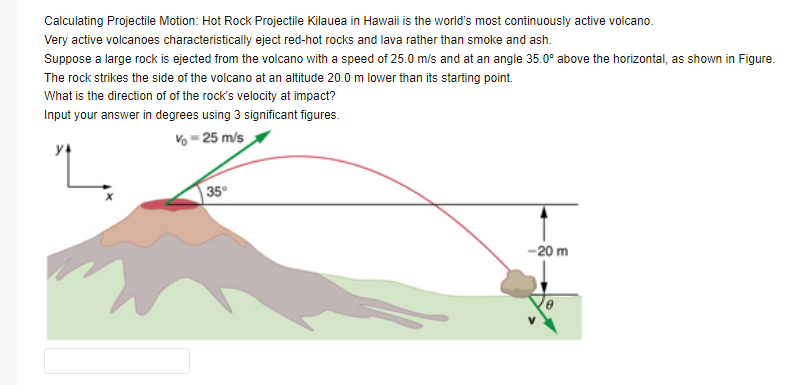Calculating Projectile Motion: Hot Rock Projectile Kilauea in Hawaii is the world's most continuously active volcano. Very active volcanoes characteristically eject red-hot rocks and lava rather than smoke and ash. Suppose a large rock is ejected from the volcano with a speed of 25.0 m/s and at an angle 35.0° above the horizontal, as shown in Figure. The rock strikes the side of the volcano at an altitude 20.0 m lower than its starting point. What is the direction of of the rock's velocity at impact? Input your answer in degrees using 3 significant figures. Vo = 25 m/s y4 35° -20 m
Calculating Projectile Motion: Hot Rock Projectile Kilauea in Hawaii is the world's most continuously active volcano. Very active volcanoes characteristically eject red-hot rocks and lava rather than smoke and ash. Suppose a large rock is ejected from the volcano with a speed of 25.0 m/s and at an angle 35.0° above the horizontal, as shown in Figure. The rock strikes the side of the volcano at an altitude 20.0 m lower than its starting point. What is the direction of of the rock's velocity at impact? Input your answer in degrees using 3 significant figures. Vo = 25 m/s y4 35° -20 m
College Physics
1st Edition
ISBN:9781938168000
Author:Paul Peter Urone, Roger Hinrichs
Publisher:Paul Peter Urone, Roger Hinrichs
Chapter3: Two-dimensional Kinematics
Section: Chapter Questions
Problem 15CQ: For a fixed initial speed, the range of a projectile is determined by the angle at which it is...
Related questions
Question
make the answer visible and bold to not confuse

Transcribed Image Text:Calculating Projectile Motion: Hot Rock Projectile Kilauea in Hawaii is the world's most continuously active volcano.
Very active volcanoes characteristically eject red-hot rocks and lava rather than smoke and ash.
Suppose a large rock is ejected from the volcano with a speed of 25.0 m/s and at an angle 35.0° above the horizontal, as shown in Figure.
The rock strikes the side of the volcano at an altitude 20.0 m lower than its starting point.
What is the direction of of the rock's velocity at impact?
Input your answer in degrees using 3 significant figures.
Vo = 25 m/s
y4
35°
-20 m
Expert Solution
This question has been solved!
Explore an expertly crafted, step-by-step solution for a thorough understanding of key concepts.
Step by step
Solved in 2 steps with 2 images

Knowledge Booster
Learn more about
Need a deep-dive on the concept behind this application? Look no further. Learn more about this topic, physics and related others by exploring similar questions and additional content below.Recommended textbooks for you

College Physics
Physics
ISBN:
9781938168000
Author:
Paul Peter Urone, Roger Hinrichs
Publisher:
OpenStax College

Principles of Physics: A Calculus-Based Text
Physics
ISBN:
9781133104261
Author:
Raymond A. Serway, John W. Jewett
Publisher:
Cengage Learning

Physics for Scientists and Engineers
Physics
ISBN:
9781337553278
Author:
Raymond A. Serway, John W. Jewett
Publisher:
Cengage Learning

College Physics
Physics
ISBN:
9781938168000
Author:
Paul Peter Urone, Roger Hinrichs
Publisher:
OpenStax College

Principles of Physics: A Calculus-Based Text
Physics
ISBN:
9781133104261
Author:
Raymond A. Serway, John W. Jewett
Publisher:
Cengage Learning

Physics for Scientists and Engineers
Physics
ISBN:
9781337553278
Author:
Raymond A. Serway, John W. Jewett
Publisher:
Cengage Learning

Physics for Scientists and Engineers with Modern …
Physics
ISBN:
9781337553292
Author:
Raymond A. Serway, John W. Jewett
Publisher:
Cengage Learning

Physics for Scientists and Engineers, Technology …
Physics
ISBN:
9781305116399
Author:
Raymond A. Serway, John W. Jewett
Publisher:
Cengage Learning

College Physics
Physics
ISBN:
9781285737027
Author:
Raymond A. Serway, Chris Vuille
Publisher:
Cengage Learning